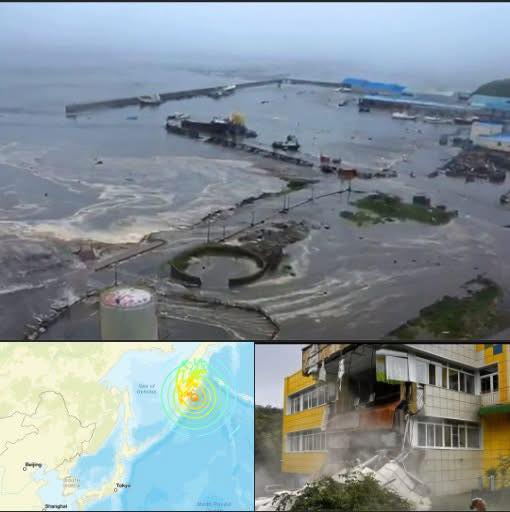In the early morning hours of July 30, 2025, a catastrophic earthquake struck off the coast of Russia’s Kamchatka Peninsula, sending tremors across the Pacific and sparking tsunami alerts in more than a dozen countries. Initially recorded as magnitude 8.0, the quake was later revised to a staggering 8.8 by the United States Geological Survey, placing it among the ten most powerful earthquakes ever recorded worldwide.
The earthquake’s epicenter was located approximately 120 to 135 kilometers southeast of Petropavlovsk-Kamchatsky, one of the largest cities in the region. Striking at a shallow depth of around 20 kilometers, the tremor unleashed an immense amount of energy along the volatile Kuril–Kamchatka arc, part of the Pacific Ring of Fire, known for producing some of the world’s most destructive quakes.
This seismic event is now considered the strongest in the Kamchatka region since 1952, when a magnitude 9.0 earthquake near Severo-Kurilsk generated tsunami waves that killed over 2,300 people. The 2025 quake did not reach that level of devastation, thanks in part to improved early warning systems, but its impact was nonetheless profound.
Tsunami waves reaching up to four meters (approximately 13 feet) battered coastal settlements such as Severo-Kurilsk on Paramushir Island. Emergency services swiftly evacuated around 2,000 residents to higher ground as seawater surged into streets and ports, damaging infrastructure and disrupting daily life. The city of Petropavlovsk-Kamchatsky also suffered widespread structural shaking—residents reported falling cabinets, swaying cars, broken mirrors, and intermittent power and mobile service outages. One kindergarten building partially collapsed, though miraculously, no fatalities were reported at the site.
Nearby Sakhalin Island saw precautionary evacuations and an emergency response mobilization, as officials prepared for potential aftershocks and tsunami surges. Their quick action helped reduce injuries and allowed first responders to assess damage more effectively.
The earthquake’s effects weren’t limited to Russia. In Japan, over 900,000 residents across several prefectures were ordered to evacuate, with authorities fearing waves up to three meters could hit the coast. Although the actual wave heights that reached locations like Ishinomaki, Nemuro, and Tokachi on Hokkaido measured only 30 to 50 centimeters, the government took no chances. At the Fukushima Daiichi nuclear plant—still under close scrutiny following the 2011 disaster—4,000 employees were temporarily evacuated. Thankfully, no damage or radiation leakage occurred.
Across the Pacific, Hawaii was placed under a state of tsunami emergency. Waves as high as 1.2 meters were reported on the islands of Oʻahu and Maui, leading to evacuations, suspended flights, and closed ports. In Alaska, smaller waves under 30 centimeters reached Adak and Amchitka, prompting a tsunami warning for the Aleutian Islands and advisories along the coast from Alaska’s Panhandle to parts of California, Oregon, and Washington. In California, Crescent City—historically vulnerable to tsunamis—was projected to receive waves nearing 1.7 meters. Residents were advised to stay away from beaches and harbors until the all-clear was given.
Other countries across the Pacific also issued tsunami advisories, including Chile, Ecuador, Peru, Mexico, Taiwan, the Philippines, Indonesia, the Solomon Islands, and New Zealand. Although most of these regions reported little to no wave impact, several governments, including Chile’s, took the precautionary step of closing coastal schools and suspending port operations. India issued an advisory for its citizens in Hawaii and on the U.S. West Coast, activated emergency contact lines, and confirmed that its nuclear facilities were unaffected.
The initial quake was followed by a series of powerful aftershocks, including a 6.9 and a 6.3 magnitude event occurring southeast of Petropavlovsk at depths of around 10 kilometers. Seismologists have warned that more aftershocks, possibly up to magnitude 7.5, could strike the region in the coming weeks. Geophysical experts also revealed that a magnitude 7.4 earthquake earlier in July, previously seen as a standalone event, was likely a foreshock to this far more destructive main quake.
The 8.8 magnitude earthquake of July 30, 2025, stands as a stark reminder of the raw power of nature. While the human toll was limited thanks to modern alert systems and rapid emergency response, the psychological and structural scars left behind are significant. Communities across Kamchatka, Japan, and the wider Pacific now face a long road to recovery, as scientists continue to monitor seismic activity and governments assess long-term damage and infrastructure resilience. This event joins the ranks of history’s most powerful quakes—not just for its intensity, but for its sweeping impact on global coastal populations and emergency preparedness.
